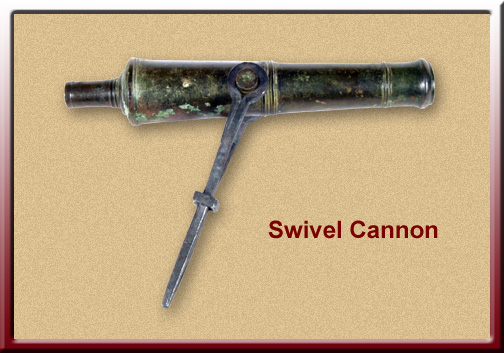The weaponry carried by the expedition members needed to do more than deter attacks and provide food, they needed to impress the Native Americans with whom American weapons could be a primary item of trade.


“accedentaly the ball passed through the hat of a woman about 40 yards distanc cutting her temple about the fourth of the diameter of the ball.”


Several anxious moments on the trail were associated with an implement which Lewis referred to in his journal as an “espontoon,” i.e., a half pike commonly carried by an eighteenth century infantry officer.


Harpers Ferry’s tiny footprint belies the richness of its roles in American history—in industrialization, in commerce, and especially in the unfolding of the Civil War and the long struggle of African-Americans out of slavery.
The Pistols
by Michael Carrick

Records show Lewis has two types of pistols along: horse pistols and pocket pistols. Early on the morning of July 27, 1806, while camped on the Two Medicine River, Lewis “ran at him with my pistol and bid him lay down my gun.”


During preparations, Lewis relied on the Harpers Ferry Armory and Arsenal for the guns and hardware that would meet his unique requirements.


Considering all he had to do to prepare for the expedition, Lewis was fortunate in that he could rely on a small cadre of Army personnel to help him assemble, pack, and ship his supplies.
Lead Powder Kegs
by Joseph A. Mussulman

Lewis ordered 52 lead canisters specially made to carry and protect the expedition’s gunpowder.


Three large pieces, two blunderbusses and a small cannon, were mounted to the three largest boats using a brass or iron swivel. These guns were used to celebrate arrivals and as a warning to those considering attacking the expedition.


Thomas Rodney stated: “It is a curious piece of workmanship not easily described and therefore I omit attempting it.” Of the Indians, Lewis wrote that it “astonishes them very much, they cannot comprehend it’s shooting so often and without powder.”


Though text, animations, and narrated video, this page provides a thorough explanation showing how a flintlock works, best practices in the field, and instructions to load and fire.
Swords
by Michael Carrick

Army regulations regarding swords were widely ignored and it is probably impossible to know exactly which type of sword Lewis or Clark would have carried.


From the seventeenth century on, French fur traders and later the British supplied their Indian clients with smoothbore muskets both as gifts and in trade for pelts. Universally called by their French name “fusils,” they were lighter and more slender than contemporary military muskets.
Muskets and Rifles
by Michael Carrick

Lewis originally had only fifteen rifles specially prepared for the expedition at Harpers Ferry armory in Virginia in 1803. Therefore, these additional enlisted men were expected to bring with them their standard-issue arms.
Experience the Lewis and Clark Trail
The Lewis and Clark Trail Experience—our sister site at lewisandclark.travel—connects the world to people and places on the Lewis and Clark Trail.
Discover More
- The Lewis and Clark Expedition: Day by Day by Gary E. Moulton (University of Nebraska Press, 2018). The story in prose, 14 May 1804–23 September 1806.
- The Lewis and Clark Journals: An American Epic of Discovery (abridged) by Gary E. Moulton (University of Nebraska Press, 2003). Selected journal excerpts, 14 May 1804–23 September 1806.
- The Lewis and Clark Journals. by Gary E. Moulton (University of Nebraska Press, 1983–2001). The complete story in 13 volumes.

